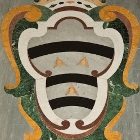History
The library of the Abbey of Cava had to be built from the very beginning of the monastery (11th century) because of the need to provide the monks with books, as required by the Rule of St Benedict. In addition to the Library as a place of preservation, there was also a Scriptorium in Cava, in which books necessary for the training of the monks of Cava and the numerous dependent monasteries were written. Evidence of this are codices no. 9 (12th century) Expositio in I Librum Regum, until a few years ago considered to be by St Gregory the Great and now attributed to the monk Pietro di Cava, no. 18 (13th century) De septem sigillis, no. 19 (13th century) Kalendarium, Evangelia, Apocalypsis, Epistola I Ioannis, Regula S. Benedicti.
The increase of the library in the 14th century is revealed by information regarding a Bible and the Speculum historiale by Vincent of Beauvais, as well as purchases for writing material and book bindings, which unfortunately have not reached us. The hypothesis put forward by Leone Mattei Cerasoli remains valid that the dispersion of the books collected in the early centuries took place in the commendatory era (1431-1497) either due to some commendatory cardinal’s love of books or due to the precarious situation that made the small number of surviving monks consider so many books unnecessary.
On the contrary, the monks of St. Justina (many incunabula record the purchase made in Venice for Cava), Abbot D. Vittorino Manso (the first to think of separating printed books from handbooks), the monks of the monastery of St. Justina, the first to have a library in Venice, and the first to have a library in Venice.
 Biblioteca Statale del Monumento Nazionale Badia di Cava
Biblioteca Statale del Monumento Nazionale Badia di Cava